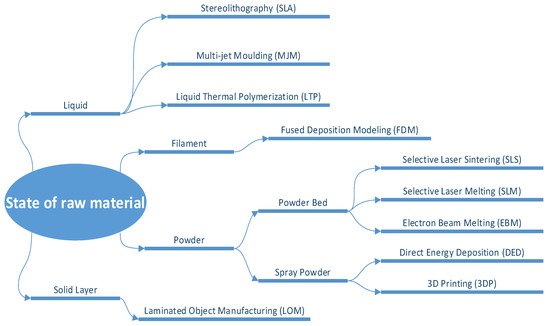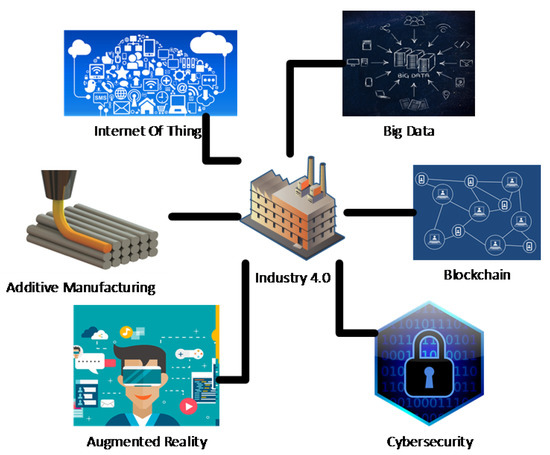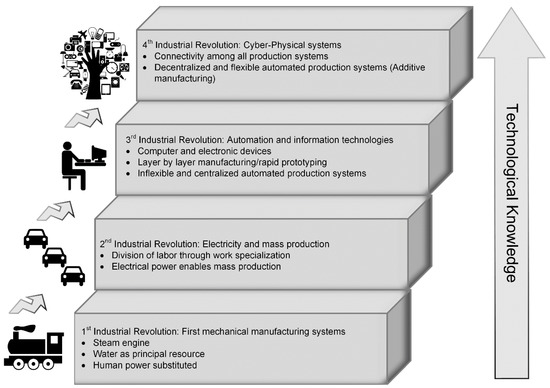
| Version | Summary | Created by | Modification | Content Size | Created at | Operation |
|---|---|---|---|---|---|---|
| 1 | Mario Hernández Korner | + 2300 word(s) | 2300 | 2020-08-11 07:54:21 | | | |
| 2 | Rita Xu | -1666 word(s) | 634 | 2020-08-13 10:19:34 | | |
Video Upload Options
We present a review on Additive Manufacturing and Industry 4.0 from business innovation and sustainability perspective.
1. Introduction
The research trend in additive manufacturing (AM)/3D printing/rapid prototyping has evolved over the past 30 years from a rapid prototyping technology to advanced manufacturing. According to Mohsen [1], the third industrial revolution started in 1987 with the commercialization of the first stereolithography (SLA) machine, named SLA-1, developed by 3D Systems. After several commercialized versions of SLA machines in 1991, three new AM-based technologies were commercialized: fused deposition modeling (FDM), solid ground curing, and laminated object manufacturing (LOM). This was followed by several years of sustained development in the AM technology from using resin to metal powder and from non-functional molding applications to fabricating medical implants [2]. At present, the focus is on the implementation of this technology in the manufacturing environment [3], considering business/operations cost implications [1][4][5][6][7], design for manufacturing or design optimization [8], and the sustainable development of this technology considering environmental implications such as the product life cycle, circular economy (CE), and use of recycled materials [9][10][11]. Few studies have reviewed the business innovation (BI) and sustainable development of the AM technology separately [12][13][14][15][16]. Industry 4.0 technologies facilitate decision making using real-time data [17][18], but others give more importance to how effective Industry 4.0 data are for environmentally sustainable implications [19][20]. Therefore, a systematic literature review and a bibliometric analysis of the AM business model and sustainability areas are needed to consider the integration of these developments into Industry 4.0.
2. Additive Manufacturing
As defined by the American Society for Testing and Materials (ASTM) and the ISO/TC 261 Committee for Standardization in Additive Manufacturing, additive manufacturing is a collection of technologies able to join materials to make objects from 3D model data, usually layer upon layer, as opposed to the subtractive manufacturing methodologies [21].
In the existing literature, AM processes have been classified by various parameters: materials used, direct or indirect process technology, and the state of the raw material used (which is one of the most commonly used basis) (See Figure 1).

Figure 1. Types of additive manufacturing processes based on state of raw materials.
Past research indicated significant advances in the AM technology in terms of its applications [22][23][24][25][26], economic impact [3][27][28][29], use of raw materials [30][31][32], and design [34][34][35]. To the best of our knowledge, the filament and powder are the most frequently used raw materials for cost characterization, business model proposals, and sustainability processes. Furthermore, the filament and powder are the most common AM technologies implemented for Industry 4.0 integration [36][37], and which are compared with traditional manufacturing methods [6][38][39][40].
3. Industry 4.0
In recent years, Industry 4.0 has seen significant advances in production processes, data management, cybersecurity, and competitiveness based on customization and client relationship (see Figure 2) [37][41][42][43]. Industry 4.0, well known as the fourth industrial revolution, was born in Germany as Industrie 4.0 in 2011 as a proposal to develop the German economy [44][45].
Industry 4.0 is characterized by interactions and communication among industrial equipment and cyber-physical systems for managing operations in real time [48] for decision-making, Internet of Things, artificial intelligence, robotics, cybersecurity, and 3D printing [49] (see Figure 3). By means of Industry 4.0, companies can use autonomous fabrication systems, make decentralized decisions, and facilitate interconnectivity among employees, machines, orders, suppliers, and customers [18][50] Technology based on Industry 4.0 enables organizations to create products that meet customers’ needs, and facilitates production parameter control such as energy consumption, material flow, and real-time monitoring [18].

Figure 3. Industry 4.0 technological trends (adapted from [37]).
Recent research established Industry 4.0 as an enabler of recent trends related to CE [36][42][51][52][53], innovation in businesses concerning manufacturing [43][54], new business models [55][56], and supply chain and cost model configuration [57].
The pursuit of increased competitiveness drives research in energy efficiency, resource redistribution, and smart equipment, which are key characteristics of Industry 4.0 [58]. The growth and proliferation of Industry 4.0 are related to the implementation of smart factories, smart products, cyber-physical systems, smart cities, and digital sustainability [45].
References
- Attaran, M. The rise of 3-D printing: The advantages of additive manufacturing over traditional manufacturing. Bus. Horiz. 2017, 60, 677–688.
- Wohlers, T. Wohlers Report 2015: Additive Manufacturing and 3D printing State of the Industry Annual Worldwide Progress Report. Wohlers Assoc. 2014, 24, 1–34.
- Bogers, M.; Hadar, R.; Bilberg, A. Additive manufacturing for consumer-centric business models: Implications for supply chains in consumer goods manufacturing. Technol. Forecast. Soc. Chang. 2016, 102, 225–239.
- Rayna, T.; Striukova, L. From rapid prototyping to home fabrication: How 3D printing is changing business model innovation. Technol. Forecast. Soc. Chang. 2016, 102, 214–224.
- Thomas, D. Costs, benefits, and adoption of additive manufacturing: a supply chain perspective. Int. J. Adv. Manuf. Technol. 2016, 85, 1857–1876.
- Urbanic, R.J.J.; Saqib, S.M.M. A manufacturing cost analysis framework to evaluate machining and fused filament fabrication additive manufacturing approaches. Int. J. Adv. Manuf. Technol. 2019, 102, 3091–3108.
- Westerweel, B.; Basten, R.J.I.; van Houtum, G.-J. Traditional or Additive Manufacturing? Assessing Component Design Options through Lifecycle Cost Analysis. Eur. J. Oper. Res. 2018, 270, 570–585.
- Thompson, M.K.; Moroni, G.; Vaneker, T.; Fadel, G.; Campbell, R.I.; Gibson, I.; Bernard, A.; Schulz, J.; Graf, P.; Ahuja, B.; et al. Design for Additive Manufacturing: Trends, opportunities, considerations, and constraints. Cirp Ann. - Manuf. Technol. 2016, 65, 737–760.
- Chen, D.; Heyer, S.; Ibbotson, S.; Salonitis, K.; Steingrímsson, J.G.; Thiede, S.; Steingrimsson, J.G.; Thiede, S.; Steingrímsson, J.G.; Thiede, S.; et al. Direct digital manufacturing: definition, evolution, and sustainability implications. J. Clean. Prod. 2015, 107, 615–625.
- Chitrao, P. 21st C New Technologies a Pathway to Inclusive and Sustainable Growth. Inf. Syst. Des. Intell. Appl. Vol 2, India 2016 2016, 434, 395–402.
- Gwamuri, J.; Franco, D.; Khan, K.Y.; Gauchia, L.; Pearce, J.M. High-Efficiency Solar-Powered 3-D Printers for Sustainable Development. Machines 2016, 4, 3.
- Savastano, M.; Bellini, F.; D’Ascenzo, F.; Scornavacca, E. FabLabs as Platforms for Digital Fabrication Services: A Literature Analysis. In Proceedings of the EXPLORING SERVICES SCIENCE, IESS 2017; Za, S and Dragoicea, M and Cavallari, M, Ed.; SPRINGER INTERNATIONAL PUBLISHING AG: GEWERBESTRASSE 11, CHAM, CH-6330, SWITZERLAND, 2017; Vol. 279, pp. 24–37.
- Costabile, G.; Fera, M.; Fruggiero, F.; Lambiase, A.; Pham, D. Cost models of additive manufacturing: A literature review. Int. J. Ind. Eng. Comput. 2017, 8, 263–282.
- Agrawal, R.; Vinodh, S. State of art review on sustainable additive manufacturing. Rapid Prototyp. J. 2019, 25, 1045–1060.
- Godina, R.; Espadinha-Cruz, P.; Ferreira, I.A.; Brás, I.; Matos, F. Knowledge Management and Additive Manufacturing Technology: A Literature Review. In Proceedings of the ECKM 2019 20th European Conference on Knowledge Management 2 VOLS; Academic Conferences and publishing limited, 2019; p. 398.
- Savolainen, J.; Collan, M. Additive manufacturing technology and business model change – a review of literature. Addit. Manuf. 2020, 101070.
- Lu, Y. Industry 4.0: A survey on technologies, applications and open research issues; Elsevier B.V., 2017; Vol. 6, pp. 1–10;.
- Shrouf, F.; Ordieres, J.; Miragliotta, G. Smart factories in Industry 4.0: A review of the concept and of energy management approached in production based on the Internet of Things paradigm. Ieee Int. Conf. Ind. Eng. Eng. Manag. 2014, 2015-Janua, 697–701.
- Qin, J.; Liu, Y.; Grosvenor, R.; Lacan, F.; Jiang, Z. Deep learning-driven particle swarm optimisation for additive manufacturing energy optimisation. J. Clean. Prod. 2020, 245.
- Turner, C.; Moreno, M.; Mondini, L.; Salonitis, K.; Charnley, F.; Tiwari, A.; Hutabarat, W. Sustainable Production in a Circular Economy: A Business Model for Re-Distributed Manufacturing. SUSTAINABILITY 2019, 11.
- Asociación Española de Normalización y Certificación Norma Española Fabricación aditiva Principios generales ISO/ASTM 52900:2015; Génova, 6 - 28004 Madrid, 2017;
- Blaya, F.; San Pedro, P.; Lopez Silva, J.; D’Amato, R.; Soriano Heras, E.; Antonio Juanes, J.; Pedro, P.S.; Silva, J.L.; D’Amato, R.; Heras, E.S.; et al. Design of an Orthopedic Product by Using Additive Manufacturing Technology: The Arm Splint. J. Med. Syst. 2018, 42, 54.
- Dias, M.R.; Guedes, J.M.; Flanagan, C.L.; Hollister, S.J.; Fernandes, P.R. Optimization of scaffold design for bone tissue engineering: A computational and experimental study. Med. Eng. Phys. 2014, 36, 448–457.
- Santolaria, J.; Monge, R.; Tobajas, Á.; Jimenez, R.; Cabrera, M.A.; Fernandez, L.J. Design, manufacture and geometric verification of rapid prototyped microfluidic encapsulations by computed tomography. Comput. Ind. 2013.
- Sutradhar, A.; Park, J.; Carrau, D.; Nguyen, T.H.; Miller, M.J.; Paulino, G.H.; Nguyen Tam H.and Miller, M.J.; Paulino, G.H. Designing patient-specific 3D printed craniofacial implants using a novel topology optimization method. Med. Biol. Eng. Comput. 2016, 54, 1123–1135.
- Zadpoor, A.A. Design for Additive Bio-Manufacturing: From Patient-Specific Medical Devices to Rationally Designed Meta-Biomaterials. Int. J. Mol. Sci. 2017, 18.
- Holzmann, P.; Breitenecker, R.J.R.J.R.J.; Soomro, A.A.A.A.; Schwarz, E.J.E.J. User entrepreneur business models in 3D printing. J. Manuf. Technol. Manag. 2017, 28, 75–94.
- Laplume, A.; Anzalone, G.C.G.C.; Pearce, J.M.J.M. Open-source, self-replicating 3-D printer factory for small-business manufacturing. Int. J. Adv. Manuf. Technol. 2016, 85, 633–642.
- Rong, K.; Patton, D.; Chen, W. Business models dynamics and business ecosystems in the emerging 3D printing industry. Technol. Forecast. Soc. Chang. 2018, 134, 234–245.
- Chen, C.; Shen, Y.; Tsai, H.-L. A Foil-Based Additive Manufacturing Technology for Metal Parts. J. Manuf. Sci. Eng. 2016, 139, 024501.
- Murmura, F.; Bravi, L. Additive manufacturing in the wood-furniture sector: Sustainability of the technology, benefits and limitations of adoption. J. Manuf. Technol. Manag. 2018, 29, 350–371.
- Zhong, S.; Pearce, J.M. Tightening the loop on the circular economy: Coupled distributed recycling and manufacturing with recyclebot and RepRap 3-D printing. Resour. Conserv. Recycl. 2018, 128, 48–58.
- Miao, X.; Zhang, Q.; Atkin, C.; Sun, Z.; Li, Y. Improving Purge Air Cooling Effectiveness by Engineered End-Wall SurfaceStructures-Part I: Duct Flow. J. Turbomach. -Trans. Asme 2018, 140.
- Pelanconi, M.; Barbato, M.; Zavattoni, S.; Vignoles, G.L.; Ortona, A. Thermal design, optimization and additive manufacturing of ceramic regular structures to maximize the radiative heat transfer. Mater. Des. 2019, 163.
- Wu, J.; Clausen, A.; Sigmund, O. Minimum compliance topology optimization of shell-infill composites foradditive manufacturing. Comput. Methods Appl. Mech. Eng. 2017, 326, 358–375.
- Mattos Nascimento, D.L.; Alencastro, V.; Goncalves Quelhas, O.L.; Gusmao Caiado, R.G.; Garza-Reyes, J.A.J.A.J.A.; Lona, L.R.L.R.L.R.; Tortorella, G.; Nascimento, D.L.M.D.L.M.; Alencastro, V.; Quelhas, O.L.G.O.L.G.; et al. Exploring Industry 4.0 technologies to enable circular economy practices in a manufacturing context A business model proposal. J. Manuf. Technol. Manag. 2019, 30, 607–627.
- Ghobakhloo, M. The future of manufacturing industry: a strategic roadmap toward Industry 4.0. J. Manuf. Technol. Manag. 2018, 29, 910–936.
- Atzeni, E.; Iuliano, L.; Minetola, P.; Salmi, A. Redesign and cost estimation of rapid manufactured plastic parts. Rapid Prototyp. J. 2010, 16, 308–317.
- Telenko, C.; Seepersad, C.C. A comparison of the energy efficiency of selective laser sintering and injection molding of nylon parts. Rapid Prototyp. J. 2012, 18, 472–481.
- Hopkinson, N.; Dickens, P. Analysis of rapid manufacturing — using layer manufacturing processes for production. Mech. Eng. Sci. 2003, 217, 31–39.
- Amir Sasson, J.C.J. The 3D printing order: variability, supercenters and supply chain reconfigurations. Int. J. Phys. Distrib. Logist. Manag. 2016, 46, 88–94.
- Nascimento, D.L.M.; Alencastro, V.; Quelhas, O.L.G.; Caiado, R.G.G.; Garza-Reyes, J.A.; Lona, L.R.; Tortorella, G. Exploring Industry 4.0 technologies to enable circular economy practices in a manufacturing context: A business model proposal. J. Manuf. Technol. Manag. 2019, 30, 607–627.
- Santos, G.; Murmura, F.; Bravi, L. Fabrication laboratories: The development of new business models with new digital technologies. J. Manuf. Technol. Manag. 2018, 29, 1332–1357.
- Mosconi, F. The new European industrial policy: Global competitiveness and the manufacturing renaissance; Routledge - Taylor and Francis Group: Oxfordshire, England, 2015; ISBN 9781317646129.
- Roblek, V.; Meško, M.; Krapež, A. A Complex View of Industry 4.0. Sage Open 2016, 6, 215824401665398.
- Egger, J.; Masood, T. Augmented reality in support of intelligent manufacturing – A systematic literature review. Comput. Ind. Eng. 2020, 140.
- Xu, L. Da; Xu, E.L.; Li, L. Industry 4.0: State of the art and future trends. Int. J. Prod. Res. 2018, 56, 2941–2962.
- Baheti, R., Gill, H. Cyber-physical Systems. Impact Control Technol. 2011, 12, 161–166.
- Manyika, J; Chui, M; Bughin, J; Dobbs, R; Bisson, P; and Marrs, A. Disruptive technologies: Advances that will transform life, business, and the global economy. McKinsey Global Institute: New York City, NY, USA, 2013.
- Lasi, H.; Fettke, P.; Kemper, H.G.; Feld, T.; Hoffmann, M. Industry 4.0. Bus. Inf. Syst. Eng. 2014, 6, 239–242.
- Kamble, S.S.; Gunasekaran, A.; Gawankar, S.A. Sustainable Industry 4.0 framework: A systematic literature review identifying the current trends and future perspectives. Process Saf. Environ. Prot. 2018, 117, 408–425.
- Beatriz, A.; Sousa, L. De; Charbel, J.; Chiappetta, J.; Godinho, M.; David, F. Industry 4 . 0 and the circular economy : a proposed research agenda and original roadmap for sustainable operations. Ann. Oper. Res. 2018, 270, 273–286.
- Dev, N.K.; Shankar, R.; Hasan, F. Resources , Conservation & Recycling Industry 4.0 and circular economy: Operational excellence for sustainable reverse supply chain performance. Resour. Conserv. Recycl. 2020, 153, 104583.
- Bienhaus, F.; Haddud, A. Procurement 4.0: factors influencing the digitisation of procurement and supply chains. Bus. Process Manag. J. 2018, 24, 965–984.
- Ibarra, D.; Ganzarain, J.; Igartua, J.I. Business model innovation through Industry 4.0: A review. In Proceedings of the Procedia Manufacturing; Elsevier B.V., 2018; Vol. 22, pp. 4–10.
- Ren, L.; Wang, S.; Shen, Y.; Hong, S.; Chen, Y.; Zhang, L. 3D Printing in Cloud Manufacturing: Model and Platform Design. In Proceedings of the Proceedings of the ASME 11th International Manufacturing Science and Engineering Conference, Blacksburg, VA, USA, 27 June–1 July 2016.
- Ivanov, D.; Dolgui, A.; Sokolov, B. The impact of digital technology and Industry 4.0 on the ripple effect and supply chain risk analytics. Int. J. Prod. Res. 2019, 57, 829–846.
- Heck, S.; Rogers, M.; Carroll, P. Resource revolution : how to capture the biggest business opportunity in a century; Houghton Mifflin Harcourt: Boston, MA, USA, 2014.





